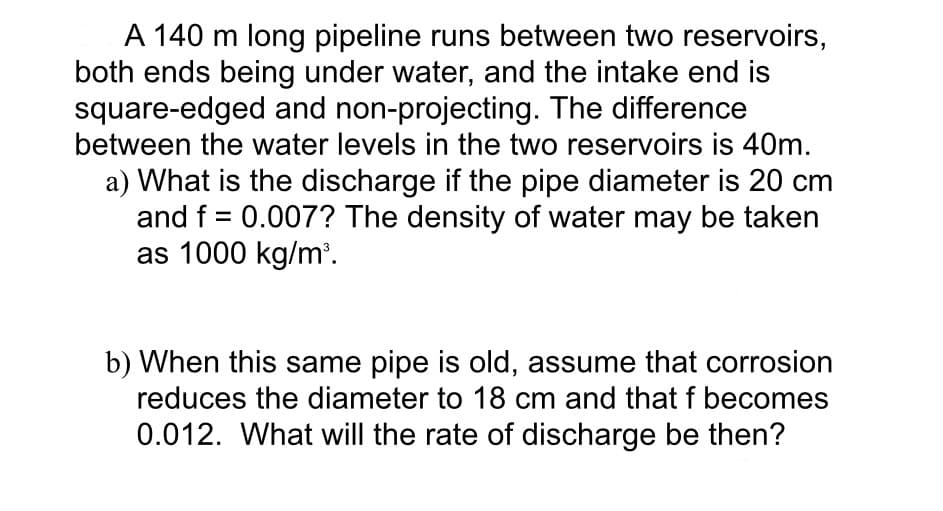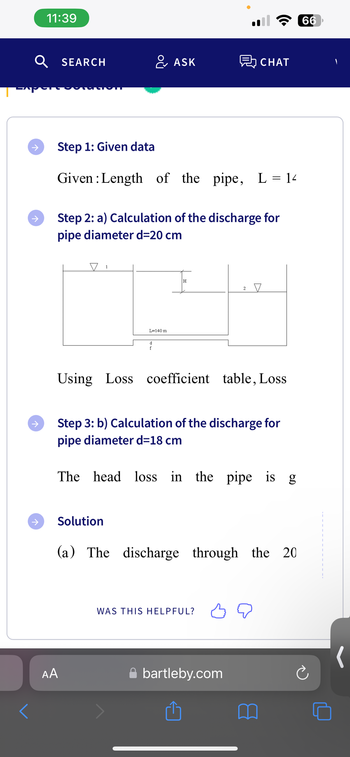A 140 m long pipeline runs between two reservoirs, both ends being under water, and the intake end is square-edged and non-projecting. The difference between the water levels in the two reservoirs is 40m. a) What is the discharge if the pipe diameter is 20 cm and f = 0.007? The density of water may be taken as 1000 kg/m³. b) When this same pipe is old, assume that corrosion reduces the diameter to 18 cm and that f becomes 0.012. What will the rate of discharge be then?
A 140 m long pipeline runs between two reservoirs, both ends being under water, and the intake end is square-edged and non-projecting. The difference between the water levels in the two reservoirs is 40m. a) What is the discharge if the pipe diameter is 20 cm and f = 0.007? The density of water may be taken as 1000 kg/m³. b) When this same pipe is old, assume that corrosion reduces the diameter to 18 cm and that f becomes 0.012. What will the rate of discharge be then?
Principles of Heat Transfer (Activate Learning with these NEW titles from Engineering!)
8th Edition
ISBN:9781305387102
Author:Kreith, Frank; Manglik, Raj M.
Publisher:Kreith, Frank; Manglik, Raj M.
Chapter6: Forced Convection Over Exterior Surfaces
Section: Chapter Questions
Problem 6.34P
Related questions
Question

Transcribed Image Text:A 140 m long pipeline runs between two reservoirs,
both ends being under water, and the intake end is
square-edged and non-projecting. The difference
between the water levels in the two reservoirs is 40m.
a) What is the discharge if the pipe diameter is 20 cm
and f = 0.007? The density of water may be taken
as 1000 kg/m³.
b) When this same pipe is old, assume that corrosion
reduces the diameter to 18 cm and that f becomes
0.012. What will the rate of discharge be then?
Expert Solution
This question has been solved!
Explore an expertly crafted, step-by-step solution for a thorough understanding of key concepts.
Step by step
Solved in 4 steps with 1 images

Follow-up Questions
Read through expert solutions to related follow-up questions below.
Follow-up Question
Can i get the answer as an image i cant see the whole write up
Tried using my laptop same issue

Transcribed Image Text:<
→
↑
11:39
SEARCH
Step 1: Given data
Given: Length of the pipe, L = 14
Step 2: a) Calculation of the discharge for
pipe diameter d=20 cm
▼ 1
L=140 m
Solution
AA
ASK
d
f
CHAT
Using Loss coefficient table, Loss
2
Step 3: b) Calculation of the discharge for
pipe diameter d=18 cm
The head loss in the pipe is g
WAS THIS HELPFUL?
v
(a) The discharge through the 20
bartleby.com
66
(
Solution
Knowledge Booster
Learn more about
Need a deep-dive on the concept behind this application? Look no further. Learn more about this topic, mechanical-engineering and related others by exploring similar questions and additional content below.Recommended textbooks for you

Principles of Heat Transfer (Activate Learning wi…
Mechanical Engineering
ISBN:
9781305387102
Author:
Kreith, Frank; Manglik, Raj M.
Publisher:
Cengage Learning

Principles of Heat Transfer (Activate Learning wi…
Mechanical Engineering
ISBN:
9781305387102
Author:
Kreith, Frank; Manglik, Raj M.
Publisher:
Cengage Learning